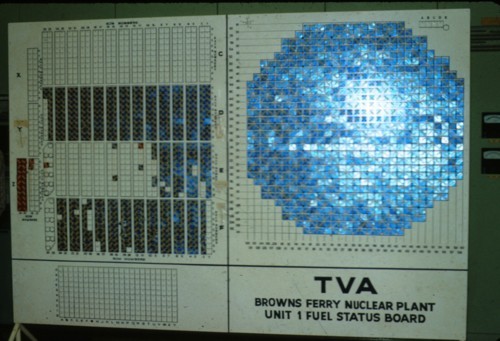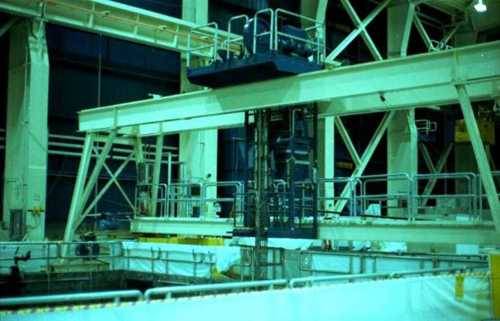 Figure 1
Figure 1
Two years after the refueling outage woes described in Fission Stories #69, the Tennessee Valley Authority (TVA) shut down the Unit 2 reactor at its Browns Ferry nuclear plant in Alabama for a refueling outage in late 1979. As happened before, this refueling outage was extended when something fell into the water that presented the risk of overheating fuel in the reactor core. This time it was not a rubber booty that fell into the water. It was a metal tag used to track fuel movements in the reactor core and spent fuel pool.
And it was not a single tag, two tags, three tag, or even a dozen tags. It was 86 metal tags.
Each tag was a thin piece of metal approximately two inches by two inches. In this case, size mattered. The inlet orifice of a fuel assembly is slightly less than two inches in diameter. Thus, a thin metal fuel tag inside the reactor vessel could conceivably be carried by the rapidly moving water flow and pinned against a fuel assembly’s inlet orifice. Blocked of cooling water flow, a fuel assembly overheats and begins to meltdown in seconds. Consequently, 86 thin metal fuel tags in the water constituted a serious safety problem.
Figure 1 shows the fuel status board for Browns Ferry Unit 1. The loading pattern of fuel in the reactor core appears on the right while the fuel storage configuration in the spent fuel pool appears on the left. Each colored square on the board is a metal tag. Little hooks allow the metal tags representing individual fuel assemblies to show their locations. During refueling outages, identical fuel status boards were maintained in the control room and on the refueling floor to assist workers plan and execute fuel movement sequences. The fuel status boards have wheels so they can be easily moved to the most advantageous viewing positions.
A refueling platform at Browns Ferry is shown in Figure 2. It is a metal bridge that spans the spent fuel pool and the water-filled cavity above the reactor vessel housing the reactor core. Each end of the refueling platform has metal wheels riding metal rails like a train or trolley car. In the figure, the refueling platform rides the rails right and left to access locations within the reactor core and spent fuel pool. The blue part of the refueling platform moves side to side. It has a telescoping boom that operators can extend downward to attach to individual fuel assemblies in the reactor core or spent fuel pool storage racks.
 Figure 2
Figure 2
Fence-like railings can be seen on either side edge of the spent fuel pool parallel to the refueling platform’s rails to guard against workers falling into the pool. The railings’ height is less than the lower edge of the refueling platform, allowing the platform to move back and forth unimpeded.
The tags ended up in the spent fuel pool because the fuel status board toppled forward and landed against the spent fuel pool railing, allowing tags to slide off their pegs and rain down into the pool. Here’s why the board toppled: A radiation protection (RP) technician wanted to create a barrier to prevent workers from entering a contaminated area. He tied a yellow and magenta rope to the spent fuel pool railing and needed something to tie the other end of the rope to. So he used the fuel status board, which was about 15 feet from the spent fuel pool.
On that fateful day at Browns Ferry, the refueling platform needed to go to the other end of the spent fuel pool for some reason. The operator began moving the platform. He did not see the rope from the fuel status board to the spent fuel pool railing. One end of the refueling bridge snagged the rope and pulled the board closer and closer to the spent fuel pool. At some point, the bridge dragged the board’s tiny wheels into the grooved slots for the platform’s rails. The fuel status board tipped over and landed against the railing. Several fuel tags fell into the spent fuel pool.
Many people within the nuclear industry thought this mistake was the stupidest act in refueling history. It is, at worst, the second stupidest act. After the board toppled against the railing, the operator stopped the refueling platform. The fuel status board was righted and moved away from the spent fuel pool railing. But, the yellow and magenta rope was left tied to the railing and to the board. When workers later returned the refueling platform to its original position later in the day, it once again snagged the rope and rolled the fuel status board over towards the pool. The second toppling dropped the remainder of the 86 missing tags into the spent fuel pool. The second episode out-stupids the first event.
After the second episode, workers removed the rope and moved the fuel status board further away from the spent fuel pool. But the damage had been done. Tags could be seen on the floor of the spent fuel pool and lying on top of fuel rods inside fuel assemblies.
Each fuel assembly moved from the spent fuel pool was checked for fuel tag “hitchhikers” before being loaded into the reactor core. Each fuel assembly was inspected using cameras to make sure that none of the missing tags had fallen into it. Although not all of the 86 tags were recovered, none seems to have gotten into the reactor vessel and blocked flow to a fuel assembly.
Our Takeaway
This event was caused by gravity and stupidity. Gravity is a constant. Stupidity need not be a constant. Perhaps the configuration leading to the initial tag dump – tying a fuel status board on wheels to a railing on the opposite side of tracks for a moving object – could have and should have been avoidable. But there’s no valid excuse for responding to the undesired outcome by resetting things to the same configuration so it could be reprised.
“Fission Stories” is a weekly feature by Dave Lochbaum. For more information on nuclear power safety, see the nuclear safety section of UCS’s website and our interactive map, the Nuclear Power Information Tracker.
